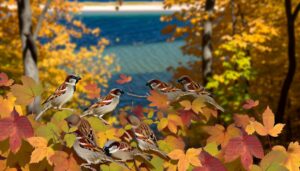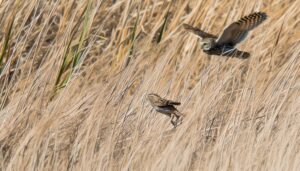Fascinating Facts: The Common House Sparrow
The House Sparrow hails from the Middle East and inhabits every continent barring Antarctica. It's remarkably hearty, able to live in desert conditions, cities, farmlands, and woodlands.
Physical traits include 14-16 cm length, a robust build, brown plumage with black streaking, and for males, a black bib. Sparrows exhibit a diverse diet, eating seeds, berries, insects and human food waste.
They practice monogamy, nesting in cavities or under eaves, with a breeding season spanning March to August. Their communication uses vocal and visual signals.
There's plenty more to uncover about the House Sparrow's fascinating world.

Key Takeaways
- Common house sparrows originated from the Middle East and now inhabit every continent except Antarctica, adapting to extreme desert conditions.
- House sparrows have a robust build measuring 14 to 16 cm in length, with brown plumage and black streaks, and males feature a distinct black bib.
- They are omnivorous, feeding on seeds, berries, and insects, and often rely on human food waste in urban areas.
- Sparrows breed from March to August, exhibit monogamous mating behavior, and both parents share responsibilities post-hatching.
- Despite being listed as 'Least Concern' on the IUCN Red List, house sparrows face threats from habitat loss, pollution, domestic cats, and climate change.
Origin and Distribution of House Sparrows
Tracing their roots back to the Middle East, house sparrows have spread across the globe, now inhabiting every continent except Antarctica. This bird species' ability to adapt to various climates and environments is truly remarkable.
They're found in urban areas, farmlands, and open woodlands. They've even adjusted to extreme desert conditions, showcasing their resilience. Their rapid proliferation can be attributed to human activities, as they often associate with human settlements for food and nesting sites. This relationship has facilitated their unintended introduction to many regions.
However, their distribution isn't uniform. In certain areas, such as parts of Australia and America, their numbers are dwindling due to habitat loss and competition with native birds. Understanding these trends is vital for managing their impact on local ecosystems.
Physical Characteristics and Lifespan
Moving from their global spread to a more intimate look, let's examine the physical traits that define house sparrows and explore their expected lifespan.
House sparrows are small birds, typically measuring between 14 to 16 centimeters in length, with a wingspan of 20 to 25 centimeters. They've a robust build, providing ability to endure diverse environments. Their plumage is primarily brown with black streaks, and males often sport a distinct black bib. Females exhibit more muted colors for camouflage. House sparrows have a powerful beak adapted for seed eating.
Their lifespan, though variable, averages at around three years. However, in protected environments with ample resources, they've been known to live up to 13 years, showcasing their resilience and adaptability.
The House Sparrow Diet
The diet of the House Sparrow is remarkably omnivorous, inclusive of both plant and animal matter. Within these broad categories, the sparrow exhibits preferences for specific food items which will be thoroughly examined.
Additionally, the influence of dietary variation on the bird's health and behavior, largely mediated by environmental fluctuations, deserves a focused investigation.
Sparrow's Common Food Sources
In their relentless quest for sustenance, house sparrows mainly feed on seeds, berries, and insects, showcasing a diet that's rich in diversity and adaptability. Seeds of grains and weeds are among their top choices, while berries offer them a sweet variety. Insects, on the other hand, provide protein essential for their growth and development.
The table below presents a summary of their common food sources:
| Food Source | Benefit |
|---|---|
| Seeds | Provide carbohydrates for energy |
| Berries | Offer a variety of vitamins and minerals |
| Insects | Supply protein for growth and development |
This varied diet equips sparrows with the necessary nutrients, ensuring their survival in diverse habitats. Observations show that these birds are opportunistic feeders, illustrating the adaptability of their feeding behavior.
Impact of Diet Variation
Diet variation plays a pivotal role in the house sparrow's adaptability, directly impacting their survival and proliferation across diverse habitats. With an omnivorous diet, these birds consume an array of food items, from insects, seeds, berries, to human food waste. This dietary flexibility allows them to adjust to various environments, from urban areas to farmlands.
However, it's not without implications. Changes in diet can influence their body condition, reproductive success, and resistance to diseases. For instance, increased reliance on human-produced waste food, low in essential nutrients, can lead to poorer health conditions.
Conversely, a diet rich in insects can enhance their breeding success. Hence, the impact of diet variation on sparrows' survival and health is multifaceted and highly dependent on available food sources.
Breeding and Nesting Habits
You might find it interesting to note that common house sparrows, during their breeding season, exhibit unique nesting habits that have been extensively studied by ornithologists. They typically breed between March and August, with peak activity in the spring. They are monogamous birds, often mating for life and fiercely defending their nest sites.
Their nests, often built in cavities or under eaves, are complex structures comprising grass stems, feathers, and litter. While the female primarily focuses on incubating the eggs, both parents share feeding duties post-hatching. This cooperative behavior enhances the survival rate of their offspring.
| Breeding Behavior | Description |
|---|---|
| Breeding Season | March to August |
| Mating | Monogamous |
| Nesting Location | Cavities, under eaves |
| Parental Duties | Shared between pairs |
Communication and Social Behavior
While observing the intricacies of their nesting habits, one can't help but notice the sophisticated communication and social behavior exhibited by the common house sparrows. These avian creatures employ a complex system of vocal and visual cues to interact with their kin.
They chirp melodically to signal danger, claim territory, or attract a mate. Their fluttering wings and puffed-up feathers can indicate aggression or submission, often seen during conflicts over food or nest sites.
Surprisingly, house sparrows aren't solitary. They form flocks, demonstrating a social structure where dominance hierarchies exist. Males typically rule the roost, often seen at the highest perches, while females and younger sparrows occupy lower ones.
This hierarchical order underlines the sparrows' social order, showing a fascinating aspect of avian society.
House Sparrows and Human Interaction
House sparrows exhibit a significant presence in urban spaces, frequently interacting with humans. This interaction has a profound impact on their population, as human activities can both positively and negatively affect their numbers.
Remarkably, sparrows also play a critical role in pest control, providing a natural solution to human agricultural concerns.
Sparrows in Urban Spaces
In bustling cities around the globe, sparrows have demonstrated a remarkable adaptability to human-made environments, often nesting in densely populated areas and interacting frequently with humans. These birds favor urban structures for nesting, including building crevices and street lights, showcasing their resilience and versatility.
The following table illustrates common nesting sites and associated behaviors:
| Nesting Sites | Associated Behaviors |
|---|---|
| Building crevices | Nesting, roosting |
| Street lights | Nesting, feeding |
| Parks, gardens | Feeding, socializing |
Despite the challenges posed by city life, such as noise pollution and lack of natural food sources, sparrows have utilized human resources to their advantage. Their diet is diverse, consuming food scraps in addition to insects and seeds. This adaptability contributes to their continued presence in our cities.
Human Impact on Population
Despite their apparent adaptability to urban environments, the human impact on sparrow populations isn't always positive. Rapid urbanization, with its noise and air pollution, can decrease the birds' survival rates and reproductive success. High levels of noise pollution can interfere with sparrows' communication, affecting their mating rituals and social interactions.
Moreover, air pollution can affect the quality and availability of their food sources. Pesticides used in agriculture and gardens can also have detrimental effects, causing physiological harm or even death. In addition, the destruction of their natural habitats for construction purposes poses a noteworthy threat.
Invasive species introduced by humans can also compete with sparrows for food and nesting sites. Hence, human activities greatly influence the survival and proliferation of house sparrows.
Sparrows as Pest Controllers
Acting as natural pest controllers, sparrows aid in maintaining balance in ecosystems by consuming a significant number of harmful insects and pests. Their diet, mainly consisting of seeds and insects, includes many species that humans consider nuisances, like aphids, beetles, and caterpillars.
During breeding season, their consumption of these pests increases as they provide necessary protein for growing chicks. By controlling these pest populations, sparrows indirectly contribute to the health of trees and crops, reducing the need for chemical pesticides.
However, it's worth mentioning that their effectiveness as pest controllers can vary depending on local insect populations and other environmental factors. A more thorough understanding of sparrows' ecological role can help in developing sustainable pest management strategies.
Conservation Status and Threats
Surprisingly, the common house sparrow, a bird traditionally known for its abundant presence, is now facing significant threats, leading to a decline in its population.
These threats include:
- Habitat loss: Rapid urbanization reduces available nesting sites and sources of food.
- Pollution: Pesticides and vehicle emissions cause harmful effects on the sparrow's health.
- Domestic cats: Cats are responsible for a high number of sparrow deaths each year.
- Climate change: Extreme weather conditions can disrupt the sparrow's feeding and breeding patterns.
Such threats have led to the house sparrow being listed as 'Least Concern' on the IUCN Red List, but their population trend is decreasing. Urgent conservation actions are essential to guarantee the bird's survival.
Conclusion
In nature's grand stage, the modest house sparrow plays its role with flair. With nests nestled in our homes, it shares our breadcrumbs and sings to greet our mornings. However, its melody is diminishing, a poignant reminder of our shared planet's delicate state.
The sparrow's story, a metaphor of living together and thriving, reflects the fragile equilibrium between humanity and nature. As guardians of this equilibrium, we must safeguard the sparrow's song from ever going mute, conserving not only a species, but the balance of our shared coexistence.






